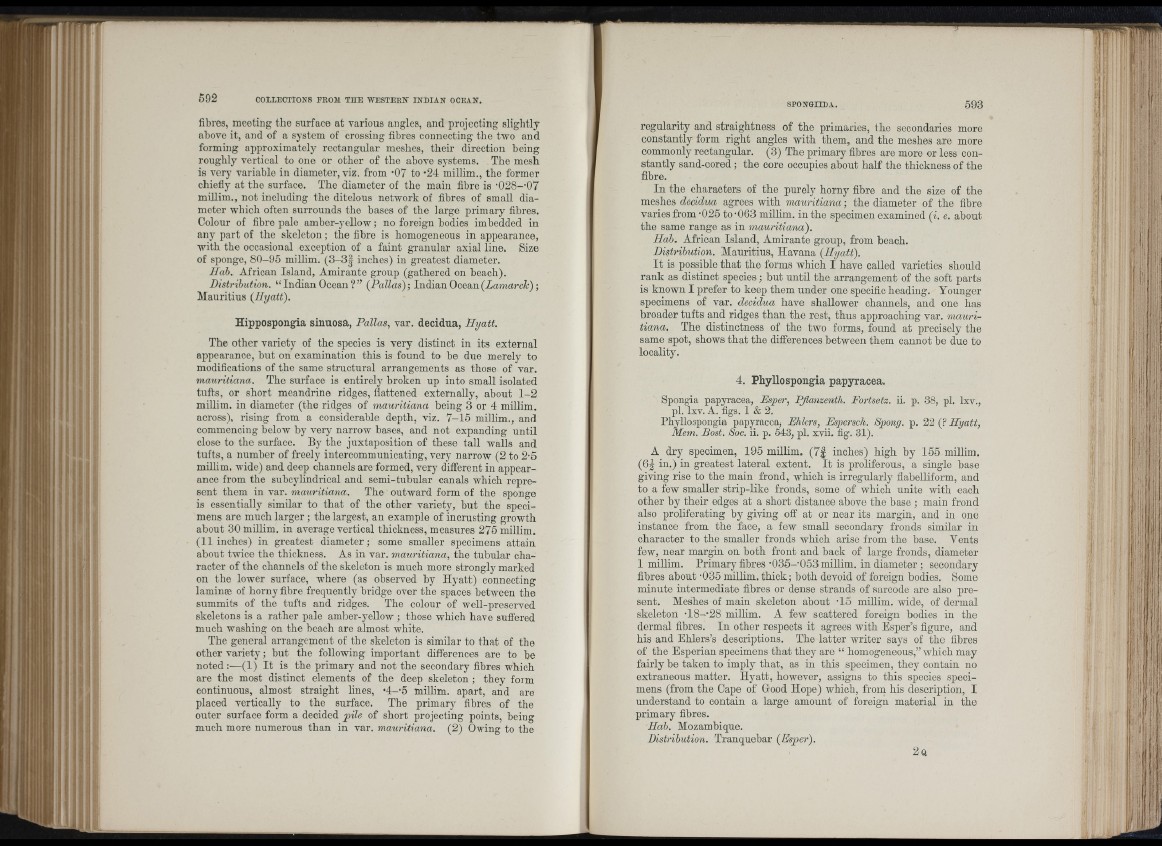
M l l - i
M l î l
• • ■ ï ■
:
Í
fibres, meeting the surface at various angles, and projecting slightly
above it, and of a system of crossing fibres connecting the two and
forming approximately rectangular meshes, their direction being
roughly vertical to one or other of the above systems. The mesh
is very variable in diameter, viz. from -07 to -24 millim., tbe former
chiefly at the surface. The diameter of the main fibre is •028--07
millim., not including tbe ditelous network of fibres of small diameter
which often surrounds tho bases of the large primary fibres.
Colour of fibre pale amber-yellow ; no foreign bodies imbedded in
any part of the skeleton ; the fibre is homogeneous in appearance,
witb tbe occasional exception of a faint granular axial line. Size
of sponge, 80-95 millim. ( 3 - 3 | inches) in greatest diameter.
Hah. African Island, Amirante group (gathered on beach).
Distrihution. “ Indian Ocean ? ” (Pallas); Indian Ocean(ZcimflrcD ;
Mauritius (Hyatt).
Hippospongia sinnosa, Pallas, var. decidua, Hyatt.
Tbe other variety of tbe species is very distinct in its external
appearance, but on examination tbis is found to be due merely to
modifications of the same structural arrangements as those of var.
mauritiana. Tbe surface is entirely broken up into small isolated
tufts, or short meandrine ridges, flattened externally, about 1-2
miUim. in diameter (tbe ridges of mauritiana being 3 or 4 millim.
across), rising from a considerable depth, viz. 7-15 millim., and
commencing below by very narrow bases, and not expanding until
close to the surface. By the juxtaposition of these tall walls and
tufts, a number of freely intercommunicating, very narrow (2 to 2-5
millim. wide) and deep channels are formed, very different in appearance
from the subcylindrical and semi-tubular canals which represent
them in var. mauritiana. Tbe outward form of the sponge
is essentially similar to th at of the other variety, but tbe specimens
are mucb larger ; the largest, an example of incrusting grovrtb
about 30 millim. in average vertical thickness, measures 275 millim.
( I I inches) in greatest diameter ; some smaller specimens attain
about twice the thickness. As in var. mauritiana, tbe tubular character
of tbe channels of tbe skeleton is mucb more strongly marked
on tho lower surface, where (as observed by Hyatt) connecting
laminæ of horny fibre frequently bridge over the spaces between the
summits of tbe tufts and ridges. Tbe colour of well-preserved
skeletons is a rather pale amber-yellow ; those which have suffered
mucb washing on the beach are almost white.
Tbe general arrangement of the skeleton is similar to th at of the
otber variety ; but the following important differences are to be
noted :•—(1) I t is tbe primary and not tbe secondary fibres wbicb
are the most distinct elements of tbe deep skeleton ; they form
continuous, almost straight lines, M-’S millim. apart, and are
placed vertically to the surface. The primary fibres of the
outer surface form a decided pile of short projecting points, being
mucb more numerous than in var. mauritiana. (2) Owing to tbe
regularity and straightness of tbe primaries, the secondaries more
constantly form right angles with them, and tbe meshes are more
commonly rectangular. (3) Tbe primary fibres are more or less constantly
sand-cored; tbe core occupies about half the thickness of tbe
fibre.
In tbe characters of tbe purely horny fibre and tbe size of tbe
meshes decidua agrees witb mauritiana; the diameter of the fibre
varies from -025 to -063 millim. in tbe specimen examined (i. e. about
tbe same range as in mauritiana).
Hab. African Island, Amirante group, from beach.
Distrihution. Mauritius, Havana (Hyatt).
I t is possible th at tbe forms which I bave called varieties should
rank as distinct species; but until tbe arrangement of the soft parts
is known I prefer to keep them under one specific beading. Younger
specimens of var. decidua bave shallower channels, and one has
broader tufts and ridges th an tbe rest, thus approaching var. mauritiana.
Tbe distinctness of the two forms, found at precisely tbe
same spot, shows th a t tbe differences between them cannot be due to
locality.
4. Phyllospongia papyracea.
Spongia papyracea, Esper, Pflanzenth. I'ortsetz. ii. p. 38, pi. Ixv.,
pi. Ixv. A. figs. 1 & 2.
Phyllospongia papyracea, Ehlers, Espersch. Spong. p. 22 (? Hyatt,
Mem. Bost. Soc. ii. p. 543, pi. xvii. fig. 31).
A dry specimen, 195 millim. ( 7 | inches) high by 155 millim.
( 6 | in.) in greatest lateral extent. I t is proliferous, a single base
giving rise to tbe main frond, which is irregularly fiabelliform, and
to a few smaller strip-like fronds, some of which unite witb each
otber by tbeir edges at a short distance above tbe base ; main frond
also proliferating by giving off at or near its margin, and in one
instance from tbe face, a few small secondary fronds similar in
character to tbe smaller fronds wbicb arise from tbe base. Yents
few, near margin on both front and back of large fronds, diameter
1 millim. Primary fibres -035--053 millim. in diameter ; secondary
fibres about -035 millim. thick; both devoid of foreign bodies. Some
minute intermediate fibres or dense strands of sarcode are also present.
Meshes of main skeleton about '15 miUim. wide, of dermal
skeleton •18-‘28 millim. A few scattered foreign bodies in tbe
dermal fibres. In other respects it agrees witb Esper’s figure, and
bis and Ehlers’s descriptions. Tbe latter writer says of tbe fibres
of tbe Esperian specimens th a t they are “ homogeneous,” which may
fairly be taken to imply that, as in tbis specimen, they contain no
extraneous matter. Hyatt, however, assigns to this species specimens
(from the Cape of Good Hope) which, from bis description, I
understand to contain a large amount of foreign material in the
primary fibres.
Hah. Mozambique.
Distrihution. Tranquebar (Esp>er).